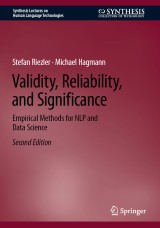Details
Validity, Reliability, and Significance
Empirical Methods for NLP and Data ScienceSynthesis Lectures on Human Language Technologies Second Edition 2024
|
42,79 € |
|
| Verlag: | Springer |
| Format: | |
| Veröffentl.: | 09.06.2024 |
| ISBN/EAN: | 9783031570650 |
| Sprache: | englisch |
| Anzahl Seiten: | 175 |
Dieses eBook enthält ein Wasserzeichen.
Beschreibungen
<p>This book introduces empirical methods for machine learning with a special focus on applications in natural language processing (NLP) and data science. The authors present problems of validity, reliability, and significance and provide common solutions based on statistical methodology to solve them. The book focuses on model-based empirical methods where data annotations and model predictions are treated as training data for interpretable probabilistic models from the well-understood families of generalized additive models (GAMs) and linear mixed effects models (LMEMs). Based on the interpretable parameters of the trained GAMs or LMEMs, the book presents model-based statistical tests such as a validity test that allows for the detection of circular features that circumvent learning. Furthermore, the book discusses a reliability coefficient using variance decomposition based on random effect parameters of LMEMs. Lastly, a significance test based on the likelihood ratios of nested LMEMs trained on the performance scores of two machine learning models is shown to naturally allow the inclusion of variations in meta-parameter settings into hypothesis testing, and further facilitates a refined system comparison conditional on properties of input data. The book is self-contained with an appendix on the mathematical background of generalized additive models and linear mixed effects models as well as an accompanying webpage with the related R and Python code to replicate the presented experiments. The second edition also features a new hands-on chapter that illustrates how to use the included tools in practical applications.</p>
<p>Preface.- Acknowledgments.- Introduction.- Validity.- Reliability.- Significance.- Worked-Through Example: Analyzing Inferential Reproducibility.- Bibliography.</p>
<p>Stefan Riezler is a full professor in the Department of Computational Linguistics at Heidelberg University, Germany since 2010, and also co-opted in Informatics at the Department of Mathematics and Computer Science. He received his Ph.D. (with distinction) in Computational Linguistics from the University of Tübingen in 1998, conducted post-doctoral work at Brown University in 1999, and spent a decade in industry research (Xerox PARC, Google Research). His research focus is on inter-active machine learning for natural language processing problems especially for the application areas of cross-lingual information retrieval and statistical machine trans-lation. He is engaged as an editorial board member of the main journals of the field—Computational Linguistics and Transactions of the Association for Computational Linguistics—and is a regular member of the program committee of various natural language processing and machine learning conferences.He has published more than 100 journal and conference papers in these areas. He also conducts interdisciplinary research as member of the Interdisciplinary Center for Scientific Computing (IWR), for example, on the topic of early prediction of sepsis using machine learning and natural language processing techniques.</p><p>Michael Hagmann is a graduate research assistant in the Department of Computational Linguistics at Heidelberg University, Germany, since 2019. He received an M.Sc. in Statistics (with distinction) from the University of Vienna, Austria in 2016, and a Ph.D. in Computational Linguistics from Heidelberg University in 2023. He received an award for the best Master’s thesis in Applied Statistics from the Austrian Statistical Society. He has worked as a medical statistician at the medical faculty of Heidelberg University in Mannheim, Germany and in the section for Medical Statistics at the Medical University of Vienna, Austria. His research focus is on statistical methods for data science and, recently, NLP. He has published more than 50 papers in journals for medical research and mathematical statistics.</p>
This book introduces empirical methods for machine learning with a special focus on applications in natural language processing (NLP) and data science. The authors present problems of validity, reliability, and significance and provide common solutions based on statistical methodology to solve them. The book focuses on model-based empirical methods where data annotations and model predictions are treated as training data for interpretable probabilistic models from the well-understood families of generalized additive models (GAMs) and linear mixed effects models (LMEMs). Based on the interpretable parameters of the trained GAMs or LMEMs, the book presents model-based statistical tests such as a validity test that allows for the detection of circular features that circumvent learning. Furthermore, the book discusses a reliability coefficient using variance decomposition based on random effect parameters of LMEMs. Lastly, a significance test based on the likelihood ratios of nested LMEMs trained on the performance scores of two machine learning models is shown to naturally allow the inclusion of variations in meta-parameter settings into hypothesis testing, and further facilitates a refined system comparison conditional on properties of input data. The book is self-contained with an appendix on the mathematical background of generalized additive models and linear mixed effects models as well as an accompanying webpage with the related R and Python code to replicate the presented experiments. The second edition also features a new hands-on chapter that illustrates how to use the included tools in practical applications.
Includes problems of validity, reliability, and significance and provides solutions based on statistical methodology introduces empirical methods for machine learning with a focus on applications in NLP and data science Presents generalized additive models and linear mixed models and utilizes R and Python to replicate



















